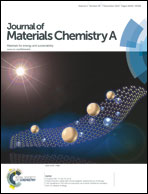Effect of La-Doping on optical bandgap and photoelectrochemical performance of hematite nanostructures†
Abstract
La-doped hematite nanotubes are fabricated by electrospinning of a sol–gel solution consisting of La(III) acetylacetonate hydrate/polyvinylpyrrolidone(PVP)/ferric acetylacetonate, and subsequent sintering at 500 °C for 5 h in air. Further grinding of these nanotubes affords La-doped hematite nanoparticles. FESEM EDX indicates that the La content is 3.66 mol% in La-doped hematite. HRTEM and XRD reveal that La3+ cations are doped into the hematite crystal lattice. UV-Vis diffuse reflectance shows increased light absorption for La-doped hematite, with the bandgap reduced from 2.58 eV to 2.46 eV. EIS and four-probe characterization demonstrate that La-doping reduces charge transfer resistance and increases the electrical conductivity, thus leading to improved charge transportation. Photoelectrochemical (PEC) water splitting studies show that under 100 mW cm−2 simulated solar irradiation, La-doped hematite nanoparticles demonstrate a net photocurrent density up to 0.112 and 0.270 mA cm−2 at 1.23 and 1.60 V vs. RHE, which are 187% and 63% higher than pristine hematite nanoparticles, respectively. The effect of La-doping on improving electrical conductivity, light absorption, and PEC performance is mainly attributed to the intensification of crystal orientation along the (110) plane and the lattice expansion caused by the La3+ cations, which have much larger radii and are more electron-rich than Fe3+.


 Please wait while we load your content...
Please wait while we load your content...